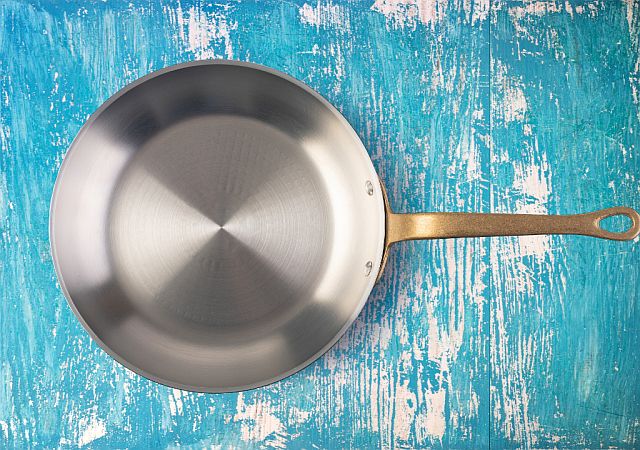Can you imagine a kitchen without stainless steel cookware? Most homes have at least some stainless steel cooking utensils. More passionate cooks are likely to have at least one carbon steel pan in addition to stainless steel cookware.
If you’re not an experienced cook but spend a lot of time in the kitchen, you probably want to use the right cookware for a particular dish. Some people prefer pans with good cooking performance, others value safety, and others prefer effortless cleaning and maintenance.
When purchasing a new frying pan, you may want to know which material best suits your needs. Today we will try to find answers to some questions you may have about two common materials used to make skillets: carbon steel and stainless steel.

1. Leaching Issues
A stainless steel pan is safer for food contact than one made of carbon steel.
Stainless steel is an iron-based steel that is alloyed with other metals to minimize corrosion and increase strength. It is a fairly inert metal alloy with a low tendency to leach chemicals into food. When used with acidic foods, a stainless steel pan can leach small amounts of nickel and chromium into your meal. This probability is lower with higher quality stainless steel grades such as types 304 and 316. Stainless steel pans with a non-stick coating do not release metals into the food as long as the integrity of the non-stick coating is not compromised.
Carbon steel pans are more likely to leach metal into your cooked food. If this pan is not seasoned well, it can release a small amount of iron during cooking, preparing, or serving food in it. This leaching intensity increases significantly when you use the pan to cook or store acidic foods such as tomato or lime juice.
When the pan is well seasoned, the layer of seasoning prevents the acid in the food from interacting with the iron. However, I wouldn’t recommend this as acidic foods can damage the seasoning.
The conclusion is that you should not use stainless steel or carbon steel pans to cook, prepare, or store acidic foods.
2. Ease of Cleaning
Stainless steel cookware is much easier to clean and maintain than carbon steel cookware.
Stainless steel cookware is very popular among users due to its easy maintenance. Most stainless steel cookware pans and sets are dishwasher safe. If you value the convenience of machine cleaning, this cookware is for you. Remember that non-stick stainless steel pans are not dishwasher safe. Even if the instructions say “dishwasher safe,” wash your nonstick cookware by hand.
Unlike stainless steel, a carbon steel pan requires a lot of maintenance. Carbon steel cookware must be hand-washed with warm water and mild dish soap. You may only use non-abrasive tools for cleaning. Additionally, carbon steel pans must be seasoned before use. With regular use, the non-stick effect of the spice coating improves. If the seasoning is damaged, you will need to re-season your pan. In addition, you must dry the pan thoroughly after each washing and store it in a dry place to avoid corrosion.
3. Durability
A carbon steel pan is sturdier, but in fact, stainless steel cookware can last longer than carbon steel pieces.
This is possible because stainless steel cookware is more resistant to corrosion, deformation, and chemicals than carbon steel. Due to the high chromium content, stainless steel is corrosion-resistant. You can expect a stainless steel pan to last quite a long time without having to apply a lot of grease.
Carbon steel is susceptible to rust in humid environments and is more flexible than stainless steel. To stay in good condition, a carbon steel frying pan requires proper maintenance, such as seasoning and proper drying. With proper care, a carbon steel pan can last for decades.
4. Aesthetic Appeal
A stainless steel frying pan looks more attractive than a carbon steel pan and retains its brand-new look for longer.
If you want to keep your pans within easy reach, you should choose stainless steel. These pans look elegant and stay bright and clean even after years of use.
A carbon steel frying pan tends to darken over time. This does not affect the functionality of the pan, but after a while, the surface no longer looks shiny and smooth. For this reason, you may want to hide such cookware in your kitchen cabinet.
5. Non-Stick Properties
The cooking surface of a seasoned carbon steel pan is more stick-resistant than a bare stainless-steel pan.
A well-seasoned carbon steel pan has solid non-stick properties. The non-stick quality improves over time.
Stainless steel itself does not make a good nonstick cooking surface. However, the pan can have an additional non-stick coating. Once the non-stick coating is damaged or worn, the pan can still be used as a regular stainless steel pan. This is possible because the stainless steel base is not very reactive.
6. Heat Conductivity and Heat Tolerance
Both metals have pure thermal conductivity, but carbon steel is a better conductor of heat than stainless steel.
Thermal conductivity is an important feature to consider when purchasing your cookware because you don’t want to wait long to heat your food. The thermal conductivity of carbon steel is about 45 watts per Kelvin per meter, while the thermal conductivity of stainless steel is about 15 watts per Kelvin per meter. Once heated, carbon steel retains heat better than stainless steel pans.
Since stainless steel is a very pure heat conductor on its own, manufacturers combine other metals such as aluminum or copper between layers of stainless steel. This multi-layer cookware offers excellent heat conduction and more even cooking.
Both materials are oven-friendly and can withstand high temperatures. However, a carbon steel pan can tolerate higher temperatures than a stainless steel pan and is better suited for some high-temperature cooking methods such as grilling.

7. Versatility
A stainless steel frying pan is more versatile than one made of carbon steel.
While a stainless steel pan can be used to cook a variety of foods, a carbon steel pan is not the ideal choice for every cooking situation. A carbon steel pan is perfect for searing, baking, braising, and frying. You can think of it as a lighter cast iron option and use it for similar tasks or those that require a lighter pan for easy maneuvering and tossing of food. It can withstand high heat and you can use it in the oven, under the grill, and for outdoor cooking. It is the best choice if you want to make Spanish paella. However, for cooking liquid meals, carbon steel is not an option as liquids would strip the seasoning.
Stainless steel cookware can be used to prepare liquid meals and is a good option for searing when you want to get a crispy golden brown crust. It’s also great for sautéing. The downside is that it can be difficult to cook high-protein and low-fat foods in a stainless steel pan without sticking, and you may need to use a lot of cooking oil.
8. Pricing
This post contains links to Amazon. The publisher may get paid if You purchase something through the links without additional costs to You.
Stainless steel frying pans are more expensive than their carbon steel counterparts.
The most expensive brands of stainless-steel skillets are Calphalon, Made In, and All-Clad (multi-ply construction).
Cuisinart 422-24 Contour Stainless 10-inch Open Skillet (with encapsulated aluminum base) is a high-performance and attractive product at an affordable price.
Carbon steel pans are significantly cheaper and you can get a decent pan at an affordable price. However, some well-known brands of carbon steel frying pans such as Made In, de Buyer, and La Paella are quite expensive.
For those who are looking for a quality product at an acceptable price, the OXO Obsidian Pre-Seasoned Carbon Steel Induction Safe Frying Pan is worth considering.



